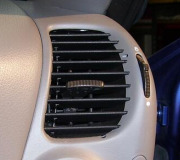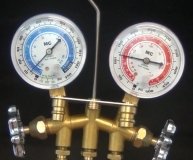What's got your dander up this time? Putting the voltage regulator inside the PCM would never be my first idea but they do give very little trouble. Also, they can kill the field current when a few more horsepower is needed such as at wide-open-throttle.
GM has always been the company famous for building assemblies that require people to buy much more than needed. Look at the HEI ignition system. A real nice ignition system but it was meant to be a unit replacement when it was new since a lot of mechanics didn't know how to work on them at first. ABS wheel speed sensors built into wheel bearings so you have to buy a complete assembly. You're going to spend way more on wheel bearings than I'm going to spend on PCMs. Who has more trouble with false ABS activation at low speed than GM?
Same with GM generators. Everything built in so you get to buy way more than you need. Why did they go to a design that has to just about be destroyed to even get to the voltage regulator, and there's no way to full-field it to test it. The old SI systems used a switch-mode voltage regulator that turned on and off 400 times per second. Turning off the current to any coil of wire sets up a voltage pulse just like in an ignition coil. Why did they never have a problem with them taking out the diodes or voltage regulator? The new CS design switches the same way but suddenly they have all kinds of trouble. Chrysler switches theirs the same way. They don't have trouble. Same with Ford. No trouble with diodes and regulators. Only GM has had this problem since they brought this design out. They even use zener diodes to help short out those voltage spikes but that doesn't completely solve the problem. When is the last time you heard of an engine running better when the generator was disabled? It was on a GM. Don't you think at some point they would design a solution to this very common problem? They've had 25 years, yet they still have the same problem. Ryan is on his third regulator or generator in six months, and this all too common. I have a friend with a '96 Buick that went through four generators in two years. The problems stopped after her battery went bad and was replaced. Another friend has a '99 GMC Suburban. I helped him put in his third, (second replacement) generator two months ago.
As for the new battery solving most of the trouble, I didn't figure that out myself. That comes from a GM corporate trainer through a Carquest trainer who puts on very high-level classes. He has a business near Chicago that specializes in that one out of a hundred cars that no other shop can diagnose. His customers are mainly other shops. He has a network of other trainers all over the country including people from every manufacturer. In fact, he drives a Buick.
At every class he starts with how a system works on one brand of car, then on the second night he goes into the odd problems and how they solved them. He doesn't waste any time on the "common" stuff. He rarely has a Chrysler-specific class because they don't have that many hard-to-diagnose problems that pertain only to that brand. Their hard-to-diagnose problems are similar to what could be found in any other car brand. That doesn't mean they're better or worse.
Same with GM. They aren't better or worse, but they sure do like to make changes. I noticed that first when a friend had a stash of oil filters for his Camaro, but when he traded it for a Firebird, the filters were different. If one was better, why didn't they use it on both cars? PCV valves are even worse. All through the '70s and '80s, Chrysler had two, GM had how many dozen? We never had the right one in stock.
I can give you a HUGE list of things I do not like about Chrysler, but business practices doesn't make that list. I don't like the regulator in the PCM, but who has the alternator that can have the brushes replaced often without removing it from the engine? The most common failure is a nine-dollar brush assembly at around 150,000 miles. By that mileage, how many GM cars still have their original AC generator yet? (Notice I didn't call it an alternator. Chrysler copyrighted that term in the '60s so now we call them "AC generators").
Getting back to air conditioning systems, I said I wasn't the expert, but the system I was referring to regulates with a variable displacement compressor. The offset of the wobble plate is adjusted by the low side pressure coming out of the evaporator. I know similar systems are used on other cars so I merely surmised GM was likely using something similar too, and if so, normal operation is the compressor clutch stays constantly engaged. If that is normal operation, then it cycling on and off would be due to low charge. I know there's a good chance I'm wrong, as we all know you love to point out, but at least I've suggested a few more things to consider and look for.
You're right about needing gauges but that isn't going to tell the whole story. There's no way to know how much refrigerant was in the system before more was added, so we don't know if the system is overcharged or if there's a leak and it's undercharged. All we can do is go by the observation that the system appeared to work okay for a while after refrigerant was added. What's the first thing YOU would do if you were asked to diagnose this car? You'd open the hood and look at it. Can't do that here. What else? You'd listen to it. Can't do that either. All you got is the information given and from those observations ten people are going to suggest ten different things.
The additional clue is the AC problem seems to have been fixed by fixing the generator, ... Twice. So do we infer that the third time for the same symptom is caused by the same defect? If not, it would be quite the coincidence to solve a problem twice with the same remedy but not the third time. Coincindenses do happen, but you have to consider GM's track record for generator problems. When you have such a common problem staring you in the face, it's silly to go looking elsewhere for the less-likely causes first. To say it can't be the generator because it's new doesn't cut in this case. Once it is ruled out, THEN you have to consider that there's an AC problem that has nothing to do with the charging system, and given the symptoms and previous repairs, a leak in the system is a real good possibility regardless of what type of system is used on that car.
Wednesday, March 28th, 2012 AT 3:34 AM



